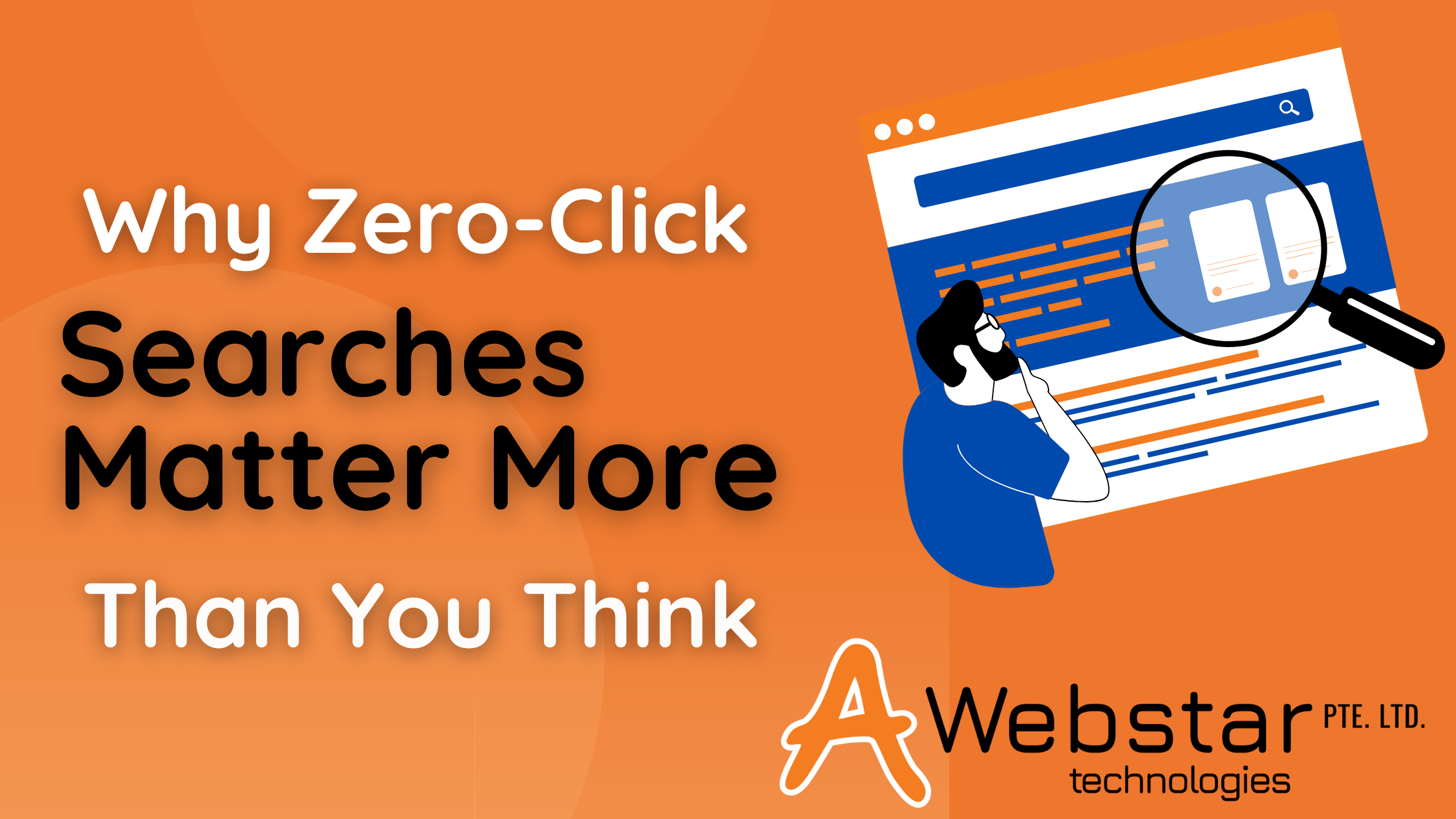
Here’s a stat that’ll make you pause
Nearly 60% of all Google searches now end without a single click to ANY website.
That’s right. Users are getting their answers directly on Google’s search results page.
In fact, this isn’t a recent trend. The numbers have been climbing steadily:
Zero-click searches jumped from 50% in 2019 and 70% in 2025. And they’re still growing.
What’s driving this massive shift?
Google’s answer features, such as. AI Overviews, featured snippets, and knowledge panels now provide instant answers to user questions. Why click through to a website when Google gives you everything you need right there?
But here’s the thing:
This creates a massive challenge AND a huge opportunity for your business.
Yes, your website traffic might take a hit. But your brand visibility? That can actually skyrocket if you know how to play this game.
The question is: Are you ready to adapt your SEO strategy to this new reality?
This guide will show you exactly what zero-click searches mean for your business. You’ll get fresh data, real examples, and practical strategies to optimize your content for this new search landscape.
The best part?
You’ll learn how to turn this apparent threat into a competitive advantage.
Let’s dive in.
What Zero-Click Searches Actually Are (And Why They Matter)
The game has changed completely.
Your users find answers without ever stepping foot on your website. And this hasn’t happened occasionally it’s become the new normal.
What exactly is a zero-click search?
Simple: It’s when someone searches on Google and gets their answer right there on the results page. No clicking required.
Think about it. When was the last time you searched for “weather today” and actually clicked through to Weather.com? Or looked up a restaurant’s hours and visited their website?
You probably got everything you needed directly from Google.
In fact, about 60% of Google searches now end this way. That’s a massive shift from the old days of “ten blue links.”
Zero-click searches come in several flavors:
- Featured snippets: Those answer boxes at the top that give you direct answers
- Knowledge panels: The info boxes on the right side with facts about people, places, or things
- People Also Ask (PAA): Those expandable questions that pop up with quick answers
- Local packs: Maps and business listings for “near me” searches
- AI Overviews: Google’s new AI-powered answer blocks (more on these later)
How Google became an answer machine
Here’s what happened:
Google realized that giving people quick answers keeps them happy. And happy users = more searches = more ad revenue.
The transformation started with featured snippets back in 2014. But AI Overviews in 2024? That was the real game-changer.
This is exactly what SEOs were worried about with AI Overviews. They’re not quick answers they’re comprehensive responses that cover everything a user might want to know. We’re talking about answer blocks that take up half your screen on both desktop and mobile.
The technology behind this is pretty impressive (and scary, depending on your perspective). Google uses a customized version of its Gemini AI model, trained on billions of webpages. It can pull information from multiple sources and synthesize it into one coherent answer.
For local businesses, this means Google shows your hours, phone number, reviews, and directions right in the search results. Great for visibility, not so great for website traffic.
The new reality: clicks are becoming rare
Let me hit you with some sobering numbers:
For every 1,000 Google searches in the US, only 360 clicks go to non-Google websites. In Europe, it’s slightly better at 374 clicks.
Mobile users are even less likely to click. Almost half of all mobile searches in both the US and EU end without any clicks, which is more than double the rate on desktop. Plus, about 22% of searches lead to another search.
The trend is getting worse for website owners. In March 2025, 40.3% of U.S. searchers clicked on an organic result, down from 44.2% the year before. Meanwhile, zero-click searches jumped from 24.4% to 27.2%.
But here’s what’s really interesting:
Google is keeping more traffic for itself. About 14.3% of U.S. searches now result in clicks to Google-owned properties like YouTube or Maps, up from 12.1% a year earlier.
This breaks the old deal between Google and website owners. You used to let Google to crawl your content in exchange for traffic. Now? Google keeps the traffic and gives users your content without sending them your way.
The message is clear: if you want to stay visible in this new search world, you need to adapt your strategy fast.
The Numbers Don’t Lie: Zero-Click Searches Are Taking Over
Ready for some eye-opening data?
The numbers paint a pretty clear picture of where search is headed. And if you’re a website owner, you might want to sit down for this.
The 2025 Zero-Click Reality
In the United States, 58.5% of Google searches now end without any clicks. The European Union? Even worse at 59.7%.
But here’s what really hit home:
For every 1,000 Google searches in the US, only 360 result in clicks to non-Google websites. The EU does slightly better with 374 clicks per 1,000 searches going to the open web.
The trend isn’t slowing down either. Check out these numbers:
- Zero-click searches in the US jumped from 24.4% to 27.2% between March 2024 and March 2025
- Organic clicks dropped from 44.2% to 40.3% during the same period
- B2B companies are getting hit even harder, with traffic reductions averaging 30% for businesses with high AI query coverage
And where are the remaining clicks going?
About 14.3% of US Google searches now send users to other Google-owned properties like YouTube and Maps. That’s up from 12.1% a year earlier. YouTube has become the top destination for traditional search across US, EU, and UK markets.
Translation: Google is keeping more traffic for itself.
Mobile Users Are Even More Likely to Skip Your Site
If you think desktop and mobile users behave the same way, think again.
Almost half of all mobile searches in both the US and EU end of the browsing session entirely. That’s more than DOUBLE the rate we see on desktop devices.
Why does this matter?
Because Bain’s research found that about 80% of consumers rely on these instant answers for at least 40% of their searches. This dependency has reduced organic web traffic by an estimated 15% to 25%.
Mobile users want quick answers. And when they get them directly from Google, they don’t need to visit your site.
Plus, about 22% of searches result in users modifying their query to perform a new search rather than clicking any results.
AI Overviews: The Game Changer
Here’s where things get really interesting.
Google’s AI Overviews feature launched in 2024 and now appears in over 13% of all searches. And it’s growing FAST.
The growth trajectory is honestly pretty remarkable:
- AI Overviews appeared in 6.49% of queries in January 2025
- This increased to 7.64% in February (18% growth)
- By March 2025, they reached 13.14% (72% growth from February)
Google initially rolled out AI Overviews, then scaled them back in May 2024. But the feature has continued expanding. BrightEdge estimates that 70% of B2B searches now include AI answers.
But here’s something unexpected:
When comparing the same keywords before and after they started showing AI Overviews, the zero-click rate actually decreased slightly from 38.1% to 36.2%. This suggests the relationship between AI Overviews and user behavior is more complex than we initially thought.
Still, the numbers are staggering. Google reported in Q1 2025 that AI Overviews is being used by 1.5 billion people monthly.
That’s a fundamental shift in how people access information online.
Your SEO Strategy Got Turned Upside Down
To be honest, everything you thought you knew about SEO success is changing.
Traffic isn’t the only game in town anymore. And if you’re still measuring SEO success purely by clicks to your website, you’re missing the bigger picture.
The New Rules of SEO in a Zero-Click World
Here’s what I’ve learned from working with hundreds of businesses:
The traditional SEO playbook is broken.
Remember when ranking #1 meant guaranteed traffic? Those days are over. For every 1,000 Google searches in the United States, only 360 clicks now reach non-Google websites.
This fundamental shift means you need to completely rethink what “winning” looks like.
Your new SEO strategy must focus on:
- Visibility in featured snippets – Not organic rankings
- Brand presence in AI Overviews – Even without clicks
- Impressions and SERP real estate – Not click-through rates
But here’s the surprising part:
Users who DO click through after seeing zero-click results often have much higher intent. As one expert puts it: “While AIOs may result in fewer clicks to your website, if you show up in AIO and someone does click on your website, they are probably more qualified and more likely to convert”.
The Traffic Drop That’s Scaring Everyone
Let me show you how dramatic this shift has been.
Organic click-through rates have been falling off a cliff:
- US organic clicks dropped to 40.3% in March 2025 (down from 44.2% the previous year)
- European markets show similar declines, falling from 47.1% to 43.5%
- Some industries report traffic reductions of 15-25% due to zero-click behavior
If you’re like most business owners, these numbers probably make you nervous.
But here’s what you need to understand: This decline affects nearly everyone. A recent study found that for most businesses, at least 8-12% of their total organic keywords now appear in SERP features, reducing direct website visits.
The impact hits different query types differently too. Informational searches get hammered the worst – 80% of keywords triggering AI Overviews are informational in nature.
Why Visibility Might Matter More Than Traffic
I know this sounds counterintuitive, but stay with me.
In 2025, tracking the right metrics is everything:
- Impressions and SERP presence (not clicks)
- Brand mentions within AI Overviews and featured snippets
- Citation frequency in zero-click results
Here’s the reality: “Although this might provide users with convenience and instant gratification, it poses challenges for businesses vying for user engagement and traffic to their websites”.
True.
But visibility still offers massive value. When your content appears in zero-click results, users see your brand and build recognition, even without clicking. This often leads to higher conversion rates when they eventually do visit your site.
My advice? Track the correlation between visibility and search trends alongside traffic. This helps you figure out whether changes in organic traffic come from your SEO performance or broader search trends.
Remember: For conversion-focused sites, qualified traffic still wins. As one expert states: “Conversions are king if you have a site that depends upon converting website visitors to customers”.
The question is: Are you tracking the metrics that actually matter in this new landscape?
How to Win at Zero-Click Searches
Now that you understand the problem, let’s talk solutions.
The good news? You CAN optimize for zero-click searches. But it requires a different approach than traditional SEO.
Here’s exactly how to do it:
Step #1: Use Schema Markup for Featured Snippets
Schema markup is your secret weapon for getting into featured snippets.
Think of it as giving Google a roadmap to understand your content. When you use schema markup, you’re essentially saying: “Hey Google, this is exactly what this content is about.”
The result? Your content becomes 2-10x more likely to get picked up for voice answers.
Here are the schema types, you should focus on:
- FAQ schema for frequently asked questions
- How To schema for instructional content
- Recipe schema for food preparation content
- Product schema for merchandise listings
I recommend starting with FAQ schema. It’s the easiest to implement and has the biggest impact.
Step #2: Create FAQ and HowTo Content Blocks
Want to rank in People Also Ask boxes?
Structure your content like this:
Question: How do I optimize for featured snippets?
Answer: Position your answer immediately after the question heading. Keep it between 40-60 words. Use simple language that a 9th grader could understand.
Pro tip: Include the actual question in your H2 or H3 tags. Google loves this format.
Step #3: Target People Also Ask (PAA) Opportunities
PAA boxes appear in almost every search result now. And they’re GOLDMINES for zero-click visibility.
Here’s my process:
First, use tools like Semrush or Ahrefs to find question-based keywords in your niche.
Next, create content that directly answers these questions. Keep your responses brief but comprehensive.
The key? Answer the question completely within the first paragraph. Don’t make users hunt for the answer.
Step #4: Build E-E-A-T for AI Overviews
AI Overviews favor content with strong Experience, Expertise, Authoritativeness, and Trustworthiness signals.
Translation: Google’s AI wants to see that you actually know what you’re talking about.
Here’s how to build E-E-A-T:
Include real case studies and practical examples from your own experience. Add detailed author bios that highlight relevant expertise. Show, don’t tell.
Remember: AI systems can spot fake expertise from a mile away.
Step #5: Optimize for Voice and Mobile Search
Most voice search users are on mobile devices. So your content needs to work perfectly on the phones.
Format your content:
- Clear, descriptive headings
- Bullet points (like this list)
- Numbered steps
- Short paragraphs
Also, write like people actually talk. Voice searches are conversational, not keyword-stuffed.
Instead of “best SEO strategies,” optimize for “what are the best SEO strategies?”
See the difference?
The bottom line: Zero-click optimization isn’t rocket science. But it does require a shift in how you think about content creation.
Ready to see these strategies in action? Let’s talk about the future of search…
What’s Next? The Future of Search (And How to Win)
The search game is changing FAST.
And if you want to stay ahead, you need to think beyond traditional SEO.
Welcome to the era of Answer Engine Optimization.
Answer Engine Optimization (AEO): Your New Best Friend
Forget everything you know about traditional keyword optimization.
AEO is different. Instead of targeting broad keyword visibility, it focuses on one thing: getting your content into quick-answer formats like featured snippets and voice search results.
Why does this matter?
Because users now expect swift, concise responses without clicking through to websites. They want answers to “Know” or “Know Simple” queries delivered instantly.
Here’s how AEO works:
• Structure your content to lead with value and provide answers upfront • Establish authority on topics with well-organized, scannable information
• Improve content readability through formatting that answer engines can easily parse
Think of it as SEO for the age of instant answers.
Brand Visibility in a No-Click World
Here’s something most people don’t realize:
In a zero-click environment, brand visibility becomes THE core metric of success.
When users get answers directly from search results, brand awareness happens without any recorded activity on your website. If your brand doesn’t show up in those micro-moments via snippets or AI overviews, you basically don’t exist to that user.
The customer journey has completely flattened. The old path search → click → site visit → conversion is now non-linear or bypassed entirely.
This makes branded searches incredibly valuable. They often result in direct engagement compared to general queries.
How to Adapt (3 Essential Steps)
Ready to future-proof your search strategy? Here’s exactly what you need to do:
Step 1: Make Your Content AI-Readable
Structure your content with clear headings and semantic richness. Implement schema markup to define entities and relationships. Write concise, answer-ready summaries that AI can easily extract.
Step 2: Build Trust and Authority
AI engines prioritize credible sources more than ever. This makes earned media incredibly valuable. Focus on authenticity and thought leadership. Put your internal experts front and center. Create content with personality, not with keywords.
Step 3: Shift Your Metrics
Stop obsessing over clicks. Start tracking search impressions and AI reach instead. Optimize for influence over direct conversions.
The future belongs to brands that master technical optimization for AI readability while experimenting with visibility strategies for both search engine AI overviews and other AI engines.
Are you ready to make the shift?
Your Next Move in the Zero-Click World
The writing’s on the wall.
Zero-click searches aren’t going anywhere. In fact, they’re only getting bigger.
But here’s what I want you to remember:
This isn’t the end of SEO. It’s the beginning of a new era.
Yes, the old playbook is dead. Chasing traditional traffic metrics won’t cut it anymore. But that doesn’t mean you’re out of options.
It means you need to get smarter about how you play the game.
Here’s your action plan:
Start tracking what matters now. Forget about obsessing over click-through rates. Focus on impressions, brand mentions in AI Overviews, and visibility in featured snippets.
Make your content answer-ready. Structure everything for direct answers. Use schema markup. Create FAQ sections. Make it easy for AI to extract and display your content.
Think beyond your website. Your brand can win even when users never click through. Every time you appear in a zero-click result, you’re building awareness and authority.
Embrace Answer Engine Optimization. It’s not about ranking for keywords anymore. It’s about providing the exact answers people are looking for.
The bottom line?
The businesses that adapt fastest will win big. While your competitors struggle with declining traffic, you can dominate the zero-click landscape.
Remember: appearing in these prominent search features builds brand recognition even without clicks. And when people do visit your site, they’ll already know who you are.
So here’s my question for you:
Will you cling to the old SEO playbook and watch your visibility fade? Or will you embrace this new reality and position your brand where people find information today?
The choice is yours. But I know which one I’d pick.
Time to get started.
FAQs
Q1. What exactly is a zero-click search? A zero-click search occurs when a user gets their answer directly on the search engine results page without clicking through to any website. This phenomenon has grown significantly, with about 60% of Google searches now ending without users clicking on any result.
Q2. How do zero-click searches impact SEO strategies? Zero-click searches require a shift in SEO focus. Instead of solely targeting website traffic, businesses now need to optimize for visibility in featured snippets, knowledge panels, and AI Overviews. Success metrics are evolving to include impressions and brand presence in zero-click results, not clicks.
Q3. What are some effective ways to optimize for zero-click searches? To optimize for zero-click searches, implement schema markup to enhance featured snippet eligibility, create FAQ and How To content blocks, optimize for People Also Ask boxes, improve E-E-A-T signals for AI Overviews, and structure content for voice and mobile search.
Q4. How does the rise of zero-click searches affect organic traffic? The increase in zero-click searches have led to a decline in organic click-through rates and website traffic. Recent data shows that organic clicks in the US dropped to 40.3% in March 2025, down from 44.2% the previous year, with some industries reporting traffic reductions of 15-25%.
Q5. What is Answer Engine Optimization (AEO) and why is it important? Answer Engine Optimization is a strategy focused on structuring content to provide direct answers to user queries, specifically targeting quick-answer formats like featured snippets and voice search results. It’s becoming increasingly important as search behavior evolves towards expecting swift, concise responses without clicking through to websites.















































